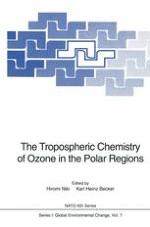1993 | OriginalPaper | Buchkapitel
Meteorology and Transport of Air Masses in Arctic Regions
verfasst von : Trond Iversen
Erschienen in: The Tropospheric Chemistry of Ozone in the Polar Regions
Verlag: Springer Berlin Heidelberg
Enthalten in: Professional Book Archive
Aktivieren Sie unsere intelligente Suche, um passende Fachinhalte oder Patente zu finden.
Wählen Sie Textabschnitte aus um mit Künstlicher Intelligenz passenden Patente zu finden. powered by
Markieren Sie Textabschnitte, um KI-gestützt weitere passende Inhalte zu finden. powered by
Airborne dispersion of a gravitationally neutral tracer is determined by the macroscopic atmospheric motions. These atmospheric motions generally take shapes as wavelike meanders and closed circulations, in short generally referred to as eddies. The nature of the transport of air parcels is determined by the kinetic energy of these eddies as a function of their size and fluctuation period. According to Taylor’s statistical theory of plume-diffusion (particles continuously released over an infinitely long time in a fixed point [e.g., Pasquill and Smith, 1983], the energy-containing eddies with periods longer than the elapsed time (T) since the particle release determine the further plume shape. In reality, emissions take place over a finite time interval, or one is interested in the shape averaged over a finite time interval Ts. Taylor’s theory can be applied as long as T ≪ Ts, otherwise puff-diffusion theory, which takes into account the diffusion of particles relative to each other, is applicable. Puff diffusion was first addressed by Richardson in the 1920s and elaborated further by Batchelor in the 1950s by using similarity theory [Pasquill and Smith, 1983]. Eddies of the same size as a puff are the most efficient contributors to the increase of the puff-size by causing a complete shape distortion, whilst those that are significantly smaller only cause a gradual entrainment of clean air by mixing through the boundaries. Eddies much larger than a puff will cause a general displacement of the puff without dilution, viz. advection.
